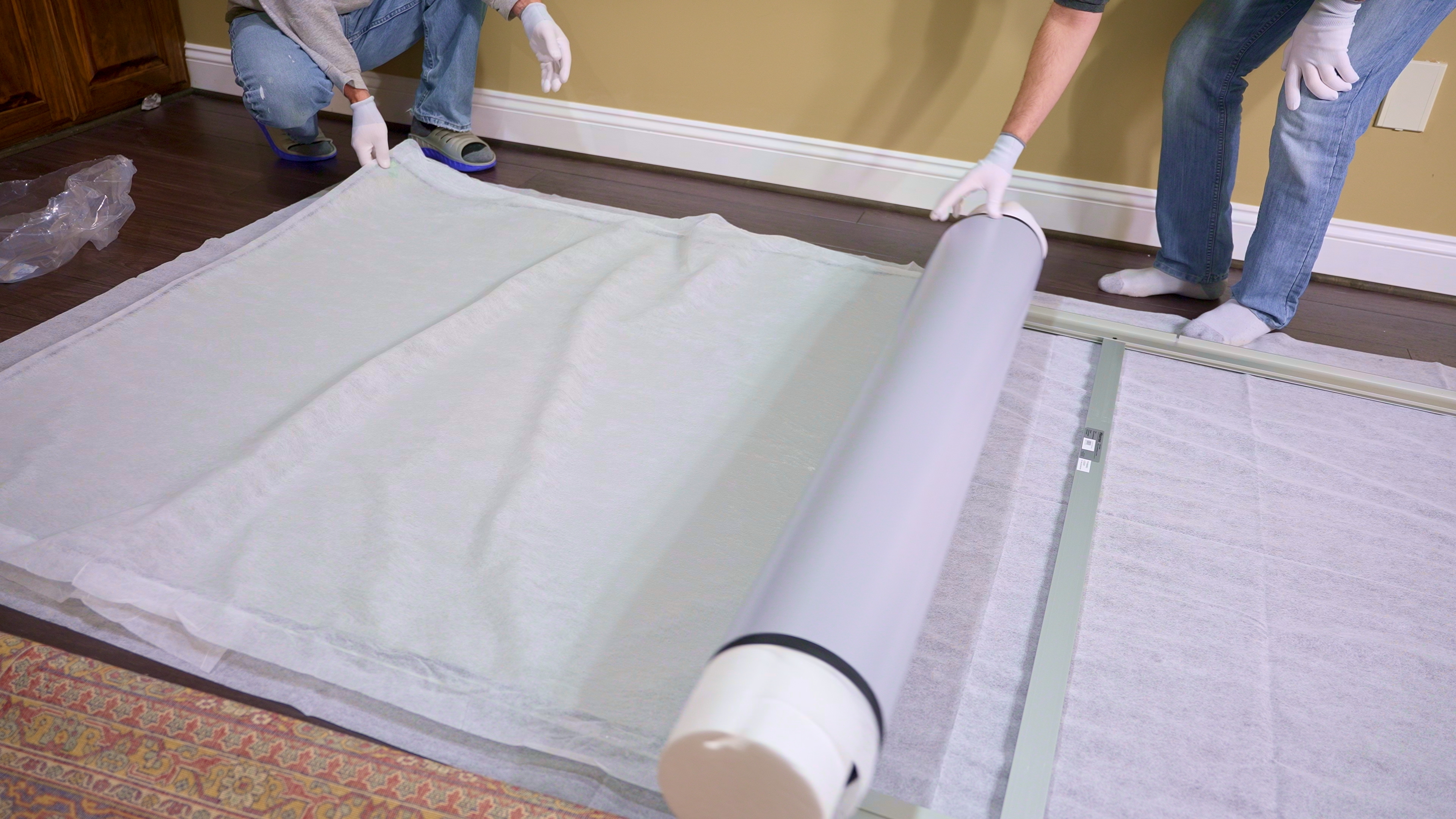I replaced my TV with this 100-inch 4K laser projector — what I like (and don't like)
Is a $5,000 Laser TV projector a better choice than a regular TV?
While it's true that the price of the best TVs in their biggest sizes is starting to come down, there's an alternative that could save you thousands — a Laser TV projector.
It’s true that you no longer need to spend $10,000+ for a 100-inch TV between a big-screen TV vs. projector, but can Laser TVs truly keep up with traditional ones? To put this to the test, I installed the $5,000 Hisense L9H Ultra-Short Throw Projector in place of a regular TV, and have been using it for the past two months.
You can see my full experience, from the unboxing process to what it’s like to use a Laser TV across a variety of content genres, in my YouTube video below. But if you want the overview of what I like, and don’t like about the Hisense L9H, read on after watching the video.
Laser TV setup and installation
I was shocked by the large size of the box it ships in. It wasn’t that heavy, weighing around 50 lbs, so it was pretty easy for my fiance and dad to carry this down from the front porch to the basement where we were installing it. But as it turns out, it’s actually the 100-inch projector screen that takes up most of the space.
Several metal pieces and rods come together to create the frame of the projector screen and apply the tension so that you get a wrinkle-free viewing experience. The last thing you'd want are shadows on your $5000 big screen.
With a regular OLED TV or QLED TV, you can pretty much set it up or mount with any of the best wall mounts so long as there’s space. With a short-throw projector, though, you first need to assemble the actual screen and its frame. You’re also going to want to plan and make sure you have enough cleared-out and clean floor space for the installation of its screen. From my experience, expect the total installation process to take up most of the day, and plan to have at least one extra pair of hands to help if possible.

Another big consideration with a setup like this, is deciding if you mind how the screen itself looks when not in use. Against lighter-colored walls, the gray screen sticks out like a sore thumb. Its black-bordered frame doesn’t do it any favors either. A TV on the other hand, while it would probably stick out a little further from the wall, would at least be a single black void, or if you're fancy, maybe your TV has an ambient mode giving you a large art canvas-like alternative.
Sign up to get the BEST of Tom's Guide direct to your inbox.
Get instant access to breaking news, the hottest reviews, great deals and helpful tips.
That said, I appreciated the projector’s low-profile screen. While many high-end TVs are extremely skinny, they are still much thicker in comparison and can’t get this close to your walls when mounted. On the other hand, though, of course, you still need to factor in the projector itself which needs to sit on a surface below at just the right height and distance away from the screen to work.
Hisense L9H picture quality
The Hisense L9H is a 4K UHD projector with 3000 ANSI Lumens, Dolby Vision & Atmos, and HDR10. It runs Google TV, with support for Apps like Netflix, Hulu, HBO, and more. If you’ve used Google TV before, the experience here is identical.
But before watching anything, I had to keystone the projection. This Laser TV Auto Keystoning, which if you’re unfamiliar, is its way of determining where the frame borders are so that it automatically adjusts its picture to look upright and straight. I was pretty disappointed with Hisense’s implementation as it never worked for me. As such, I relied entirely on manual adjustments to level the projected image as best as possible and fit it within the border of the frame.

Once the projection aligned on the screen properly, and logging in to all my streaming accounts, I was greeted with a home screen that already had our recommended content to watch. Watching James Bond: No Time to Die with all the lights turned off, I quickly forgot that this is a projector. Without making any picture adjustments, everything looked bright and vibrant. But what was most surprising was how sharp everything looked on this massive screen. Having action sequences fill up nearly an entire wall is incredible, and although its 40W Dolby Atmos speakers won’t replace a dedicated sound system, for a built-in solution, it’s quite good.
Watching the ABC Murders, I noticed the wide viewing angles off to the side of the room, with the picture maintaining consistency. I could see this making Laser TVs like the Hisense L9H the better choice if you host lots of large gatherings like Superbowl parties. But wanting to see how it looked in varying ambient light conditions, I let in some sun and turned on more lights overhead. As you might expect, the image begins to look more washed out and less saturated. Even on a mostly cloudy day, and this is still one of the biggest strengths of regular TVs in terms of picture quality.
Can you use a Laser TV for gaming?
One of the things I was most excited to use the Hisense L9H for was big-screen gaming. Using its 4K 60Hz HDMI port, I played some Cyberpunk 2077. As much as I’ve already played this game in the past both on my 49” Samsung Odyssey OLED G9 ultra-wide monitor and my 65-inch Hisense U8K TV, it’s a completely different experience at 100 inches.
When you sit close enough, the game really does fill your whole peripheral. It’s incredible for story-driven games and shooters, though I probably wouldn’t play anything competitive like Overwatch 2 where I’d prefer higher frame rates and a smaller and closer display instead.
Games like Alan Wake 2 are a perfect example of the kind of game I think this projector is best for. Turn the lights off and it’s instantly 100x spookier to play. I think this would also be the perfect party game setup for games like Smash Bros or Mario Kart on the Nintendo Switch. too.
Laser TV vs. regular TV: Biggest pros and cons
When watching movies or certain types of games, especially with lights off, the immersion and quality you get at 100 inches (or if you cough up another $1000 for the 120-inch size) is nothing short of exciting. To this day TVs still have the advantage of picture quality and ease of setup, but Laser TVs have greater size possibilities and generally lower costs; However, this price advantage is quickly changing.
When compared to similarly sized 98-inch or 100-inch TVs at their MSRPs, the $5000 asking price for 1000-inch L9H actually seems like a great deal. That said, especially around sales events, we’ve seen some very deep discounts on some models including “budget” options like the 98” TCL S5 and the 100-inch size of the Hisense U8K, which can be found for up to 50% off. So as great as the L9H is, I would still pick the U8K if I could choose between the two because of its added brightness and higher refresh rate, for the same price considering the discounts.
When I first began reviewing this projector about two months ago, the value proposition for the L9H was largely in its favor without these other deeply discounted TVs in the mix. I wouldn’t be surprised if Hisense soon discounted the L9H to make it once again the cheaper TV deal compared to TVs, and if so, it would be an easy recommendation for those looking for one of the largest at-home entertainment experiences you can buy while still trying to be price conscious.

Paul Antill is a Video Producer and Content Creator at Tom's Guide, specializing in video/audio recording, smart home technology, and laptops. His passion lies in making tech coverage not just informative but also fun and accessible to everyone answering the question “Why does this new product or feature matter to me?” Paul has been a tech host and video producer since 2019 where he has also covered major tech and gaming events. His love for tech and video began on his YouTube channel where for the low price of one subscription he shares head-to-head comparisons and clever ways to make the most of your gear. You can also see the behind-the-scenes and the magic that goes into our Tom’s Guide videos over on his Instagram. Paul graduated from the Mason School of Business at William & Mary, Williamsburg, VA, with a degree in Marketing and Business Analytics. When he's not on camera, you’ll probably still spot him behind one doing street photography and videography. Back home he’s probably in a heated Overwatch 2 match with his friends.
